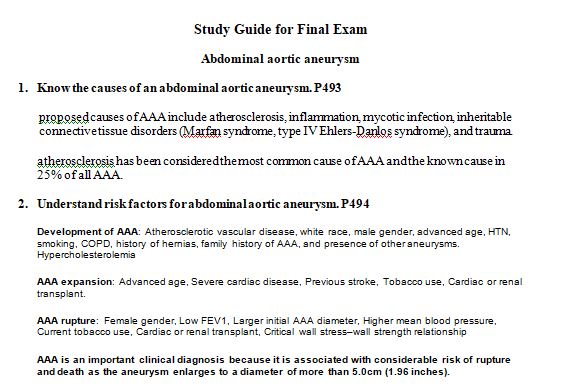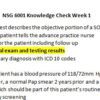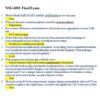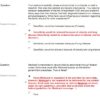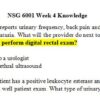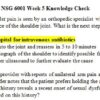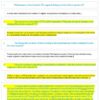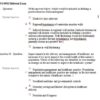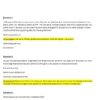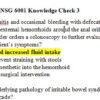Description
NSG 6001 Final Exam Study Guide
Abdominal aortic aneurysm
- Know the causes of an abdominal aortic aneurysm. P493
- Understand risk factors for abdominal aortic aneurysm. P494
- Development of AAA
- AAA expansion
- AAA rupture
- Know the symptoms of an abdominal aortic aneurysm.
- AAA is an important clinical diagnosis because it is associated with considerable risk of rupture and death as the aneurysm enlarges to a diameter of more than 5.0cm (1.96 inches).
Symptoms
- Symptom and sign of a ruptured AAA
- classic diagnostic triad of ruptured AAA is hypotension (42%), pulsatile abdominal mass (91%), and abdominal pain (58%) or back pain (70%). The triad is encountered in only 50% of patients with a ruptured AAA. Ruptured AAAs should be suspected in any patient who comes in with complaints of hypotension and atypical abdominal or back pain symptoms
- What is a Saccular Abdominal Aneurysm?
- What are the risks for abdominal aortic aneurysm?
Diagnostic Testing for CAD
- Why is CT imaging limited in women? P492
- Can ischemic changes on an ECG during or after an ETT correlate to the effected artery or arteries?
- What diagnostic test is used for CAD? P488
- Exercise Tolerance Test
- What defines a positive exercise echocardiogram?
- .Myocardial Perfusion Imaging
- Cardiac Magnetic Resonance Imaging (MRI)
- Exercise Echocardiography
- Understand the coronary flow related to CAD.
- What is the best reason to add a Doppler flow studies during an echocardiogram study?
- What changes would you see during an ETT that are highly predictive of CAD? P489
- What is an Isometric ST-segment during exercise caused by? P488
- Where would you measure the J point located on an ECG in relation to the QRS and ST-segment depression after an exercise stress test? P488
- Why would you order an ETT in a symptomatic woman with a normal ECG?
- What predictive value does a significant ST-segment elevation have for CAD? p488
- What physiological changes occur during effort in the routine ETT? nsg 6001 final exam
- What does an abnormal left ventricular ejection fraction on an echocardiogram mean for a patient during an ETT? P490
- Know the reasons for using the risk stratification according to the Farmingham risk score to justify a ETT in an asymptomatic patient.
Heart Failure
- Where could you find supporting data for guidelines for prevention of future heart disease? P456
- What are the signs of heart failure? p541
- Symptoms:
- Shortness of breath (dyspnea)
- Persistent coughing, bronchospasm, or wheezing-
- Edema
Signs
- Jugular venous distention:
- Crackles, frothy or pink sputum, pleural effusions-
- Third heart sound:
- Fourth heart sound:
- Aortic stenosis:
- Mitral regurgitation:
- Tricuspid regurgitation:
- Hepatomegaly, right upper quadrant tenderness:
- Physical Exam:
- Ascites, anasarca, or edema:
- Physical Exam:
- Altered hemodynamics:
- Tachycardia:
- Displaced point of maximal impulse:
- Hypotension, cool extremities:
